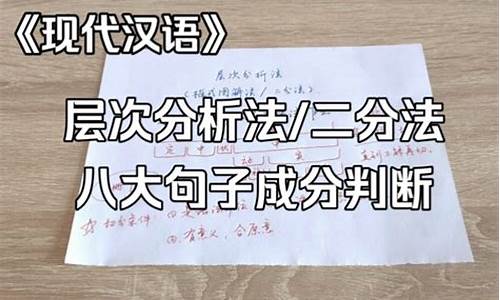您现在的位置是: 首页 > 名人语录 名人语录
八大基本句子结构_八大句子关系
tamoadmin 2024-08-24 人已围观
简介1.什么是英语句法?2.大学英语八大语法写作结构3.英语句子的八大基本结构思维导图4.文言文句式八大类型1、一般现在时:主语+do/does;用于经常性或习惯性的动作,常与表示频度的时间状语连用。2、一般过去时:主语+did;用于在确定的过去时间里所发生的动作或存在的状态。3、一般将来时:will do/;用于表示主观意愿的将来、不以人的意志为转移的客观的将来、临时决定,通常用于对话中。4、现在进
1.什么是英语句法?
2.大学英语八大语法写作结构
3.英语句子的八大基本结构思维导图
4.文言文句式八大类型

1、一般现在时:主语+do/does;用于经常性或习惯性的动作,常与表示频度的时间状语连用。
2、一般过去时:主语+did;用于在确定的过去时间里所发生的动作或存在的状态。
3、一般将来时:will do/;用于表示主观意愿的将来、不以人的意志为转移的客观的将来、临时决定,通常用于对话中。
4、现在进行时:主语+am/is/are doing;用于表示现在(指说话人说话时)正在发生的事情。
5、过去进行时:was/were doing;用于表示过去某段时间内持续进行的动作或者事情。
6、过去将来时:was/were to /would do;用于表示主观意愿的将来。
7、现在完成时:he/has done;用于表示刚刚完成的事情或活动作。
8、过去完成时:had done。用于表示在过去不同时间发生的两个动作中,发生在先,用过去完成时,发生在后,用一般过去时。
英语中的八个基本时态,即:一般现在时、一般过去时、一般将来时、过去将来时、现在进行时、过去进行时、现在完成时、过去完成时。
英文的8种时态归纳:
1. 一般现在时
①定义;表示经常性的事情,经常性的动作或一般实。
②时间状语:often,usually,always,every,sometimes,at等等。
③结构:只有在第三人称单数用动词的“三单变化”,其他用动词的原形。
④否定形式:am/is/are+not;此时态的谓语动词若为行为动词,则在其前加don't,如主语为第三人称单数,则用doesn't,同时还原行为动词。
⑤句子转换:当转换成一般疑问句时,把be动词放于句首,用助动词提问,并根据是否为第三人称单数而改动,后面的动词也要改为原形。
2. 一般过去时
①定义:表示过去某一时候或某一段时间所发生了的事情或存在的状态。
②时间状语:yesterday, this morning, just now, a moment ago, in May, last night / year / week, once upon a time, the other day, before等等。
③结构:be动词
④否定形式:was/were+not;在行为动词前加didn't,同时还原行为动词。
⑤句子转换:当转换成一般疑问句时,was或were放于句首;用助动词do的过去式did 提问,同时还原行为动词。
3. 现在进行时
①定义:表示说话时正在进行或发生的动作,也可表示当前一段时间内的活动或现阶段正在进行的动作。
②时间状语:now,at this moment,these days等等。
③结构:助动词 be ( am / is / are ) +doing。
④否定形式:be ( am / is / are ) +not +doing。
⑤句子转换:当转换成一般疑问句时,把be动词放于句首。
4. 过去进行时
①定义:表示在过去某个时间点发生或进行的行为的事情。
②时间状语:at this time yesterday, at that time或以when引导的谓语动词等等。
③结构:be (was/were )+doing。
④否定形式:be (was/were )+not+doing。
⑤句子转换:当转换成一般疑问句时,把be动词放于句首。
5. 现在完成时
①定义:表示过去发生的动作对现在造成的影响或结果或过去的动作或状态持续到现在。
②时间状语:recently, lately, since…for…,in the past few years等等。
③结构:主语+he/has +动词的过去分词。
④否定形式:主语+he/has + not +动词的过去分词。
⑤句子转换:当转换成一般疑问句时,把he/has放于句首。
6. 过去完成时
①定义:表示在过去某一时刻或动作以前完成了的动作,也可以说过去的时间关于过去的动作。即“过去的过去”。
②时间状语:by, before等介词短语。
③结构:主语+had+过去分词。
④否定形式:主语+had+ not +过去分词。
⑤句子转换:当转换成一般疑问句时,had放于句首。
7. 一般将来时
①定义:表示将来某一时刻的动作或状态,或将来某一段时间内经常的动作或状态。
②时间状语:tomorrow,next day,soon,in a few minutes,soon, by
③结构:be ( am / is / are ) going to+动词原形,shall/will+动词原形。
④否定形式:be ( am / is / are ) not going to+动词原形,shall/will not+动词原形。
⑤句子转换:当转换成一般疑问句时,把be动词/shall/will放于句首。
8. 过去将来时
①定义:表示在过去某个时间看来将要发生的动作或存在的状态。
②时间状语:the next day,the following month等等。
③结构:would/should+动词原形,be(was,were)going to+动词原形。
④否定形式:would/should not+动词原形,be(was,were)not going to+动词原形。
⑤句子转换:当转换成一般疑问句时,把be动词/would/should放于句首。
什么是英语句法?
英语句子成分:
主要成分:主语、谓语、宾语、表语 汉语中没有此成分
次要成分:定语、状语、宾补/主补、同位语.
插入语,属于修辞类的功能形式,一般都不作为句子成分看待.
例如:
To see 主语is谓语 to believe.表语
He 主语came to 谓语school 宾语late again.状语
We主语 Chinese同位语 should try harder谓语 to make our country stronger and more powerful 宾语
to make our country 宾语stronger and more powerful 宾补
Jack is a wise定语 man
大学英语八大语法写作结构
主、谓、宾、定、状、补等属于句子成分,就好比人有头、脖子、身体、腿、脚。
而名词、动词、形容词、副词等以及短语、从句是要往句子成分填充的材料。
还要知道英语有“主系表、主谓宾”两种句型,以及什么是主从句、单复句等。
以上这都是属于英语句法知识,是相当初级的知识,虽然初级和简单,但是没有这个知识储备的话,英语课就可能听不懂,句子分析也听不懂,后面的语法课也听不懂。以上知识可以在一节课的时间内了解学会,参考live:《快速建立英语句法知识体系》
在看看英语语法是怎么分的:
第一:句法知识部分, 包括英语的十大词类、两大句型、八大句子成分、主从句、单复句。
第二:语法知识部分,包括时态、语态、虚拟语气、非谓语、三大从句等等。
句法知识,是语法知识的基础,语法知识是英语学习的内核,在系统学习语法之前必须要有基本的句法知识!
句法知识让你知道句子的框架结构,语法知识让你知道句子表达的精细时空内涵,句法知识结合语法知识构成英语这座大厦的宏观框架体系,单词的深厚积累构成英语这座大厦的砖瓦水泥。
所以学习英语一定要取正确的学习顺序,不然就是拔苗助长,先天不足了。
语法的框架体系请参考《1小时建立英语时态框架体系》、《1小时掌握英语动词的秘密》两个Live,看完后基本就把英语语法的结构体系理顺了,英语语法也就基本入门了。入门后,你就可以花数周时间系统的学习《英语思维:解密英语语法的原理》图书和《英语思维:十课建立完美语法体系》完整了。
英语句子的八大基本结构思维导图
大学英语必备八大语法写作结构
导语:在大学英语写作中,如何打造一篇高分文章,词汇多变且句型丰富是重点。前者比较容易做到,后者需要扎实的语法基础。接下来我为大家总结了丰富句子的八大语法结构,希望对各位同学有所帮助。
?1. 主动句变被动句
?英文多被动,汉语多主动?,还需要警惕名词与动词之间暗含的?主被动?关系。
Eg1: It is said that ?据说/相传
Eg2:I suggest that ? It is suggested that ?
Eg3:Effective measures should be taken before things get worse.表建议
Eg4: your prompt attention to my enquiry would be highly reciated. 表感激
Eg5:Students should study hard.
Students are expected / well-advised to study hard.
?2. 简单句变从句名词性从句,含主语从句、宾语从句、表语从句和同位语从句四种;定语从句;状语从句
A. 主语从句:
Eg1:What worries many parents is that Internet or computer games may impact kids? study.
Eg2:It is said that an emperor of ancient China discovered Tea 5,000 years ago. (it为形式主语;that从句为真正主语)
B.宾语从句:
Eg1:Many Americans live on credit, and their quality of life is measured by how much they can borrow, not by how much they can earn.
Eg2: I am convinced that it is of great necessity for youngsters to study hard.
Eg3:明智的人不为别人的想法所影响。The sensible man is not influenced by what other people think.
C. 表语从句:
Eg1:That is why China is called the ?Kingdom of Bicycles?.
Eg3:In team games, practice is what improves our sense of cooperation.
D. 同位语从句
Eg1:(Martin Luther King) I he a dream that one day this nation will rise up and live out the true meaning of its creed: "We hold these truths to be self-evident, that all men are created equal." (该句中a dream = that 从句,)
Eg2:Others hold the different idea that online shopping brings us some problems.
E. 含同位语句式
A.人 身份
Eg. I am convinced that ?
As a college student, I am convinced that ?
I, as a college student, am convinced that ?
B. 物 性质
Eg. A strong will brings us power ?
As a vital quality, a strong will brings us power?
A strong will, as a vital quality, brings us power?
插入语
Eg1:As I see, the causes of this phenomenon are diverse.
The causes of this phenomenon, as I see, are diverse.
Eg2:All of a sudden, the silence of the lake was broken by a scream.
The silence of the lake, all of a sudden, was broken by a scream.
Eg3:Even so, others hold a different view.
Others, even so, hold a different view.
Eg4:Like anything else, automobiles he more than one side. (汽车跟很多其他事物一样,具有两面性)
Automobiles, like anything else, he more than one side.
F. 定语从句:
步骤:1)先写出正确简单句,确定被修饰成分(中心名词)
2)在中心名词后加入定从,关系词who, whose, whom, where, which, when
Eg1:Taobao is a particularly popular website. ? Taobao is a particularly popular website, where/in which customers can purchase various goods.
Eg2:I will advice my foreign friend to visit Great Wall, where he or she can acquire knowledge of Chinese history.?
?3. it 句式A. 形式主语 it is +被动/形容词/名词+that从句/to do ?
Eg1:It is suggested/ well-advised / supposed / proposed that sb. should (not) do ?
Eg2:It is essential / necessary / advisable / convenient/ difficult/ hard/ comfortable for sb. (not) to do
Eg3:It is essential / necessary that sb. should (not) do ?
Eg4:It is useless/useful doing sth.
B. 形式宾语
Eg1:An increasing number of students find it difficult to spell common words correctly.
Eg2:An increasing number of parents find it hard to he opportunities to chat with kids, who spend too much time on computers.
Eg3:A host of youngsters find it rather boring and hard to understand literature.
?4. 强调句A. 强调谓语:
Eg1:I love you. /I do love you. / I did love you.
Eg2:Cell phone/ Internet/ computer brings us convenience.
Cell phone/ Internet/ computer does bring us convenience.
B. 强调句式:It is/was +被强调成分+that/who+句子其他成分。
步骤
a. 先写出正确的简单句、并列句或复合句,明确单句的各个成分。
b. 在被强调成分(除谓语和补语外)两边添加it is/was 和that/who, 其他成分不变,必要时调整顺序。
强调句式特征去掉it is/was?that/who结构,整个句子无冗余或成分残缺。
Eg1:My mother always encourages me not to lose heart when I he difficulties in study.
It is my mother who/that always encourages me not to lose heart when I he difficulties in study.
It is when I he difficulties in study that my mother always encourages me not to lose heart.
Eg2:Parents? protection does not enable kids to build up adequate ability to face social competition.
(强调句式否定形式)It is parents? protection that does not enable kids to build up adequate ability to face social competition.
Eg3:The Internet does not enable some youngsters to spend adequate time in chatting with others face to face.
It is the Internet that does not enable some youngsters to spend adequate time in chatting with others face to face.
?5. 倒装A. 表否定的副词、短语或状语位于主语之前或句首,主句半倒装(一般疑问句语序);如never, seldom, hardly, scarcely, little, on no account, by mo means, in no case,
Eg1:I will never agree. Never will I agree.
B. Only +状语位于句首,主句半倒装。
Eg1:When my beloved is beside myself, I can feel the true hiness.
Only when my beloved is beside myself, can I feel the true hiness.
Eg2:When his computer crashes, he will come down-stairs for something to eat.
Only when his computer crashes, will he come down-stairs for something to eat.
Eg3:By doing small things, agers can accumulate ability and experience for something big.
Only doing small thing, can agers accumulate ability and experience for something big.
C.As/though倒装形式
Eg1:Although she is a girl, Zeng Yike is called Brother Zeng.
Girl as she is, Zeng Yike is called Brother Zeng.
Eg2:Though it is convenient, online shopping leads to some problems.
Convenient as/though it is, online shopping leads to some problems.
Eg3:Although it is simple, what the picture conveys is thought-provoking.
Simple as it is, what the picture conveys is thought-provoking.
?6.双重否定Eg1:no ____ is / are more _____ than ________.
In contemporary society, no means of communication is more popular and common than cell phones.
Eg2:A strong will is very important.
The importance of a strong will cannot be too emphasized.
Eg3:Education helps people to acquire knowledge, skills and new visions.
Without education, it is impossible for people to acquire knowledge, skills and new visions.
?7. Ving/ved 状语A. 两个动作同时发生且主语一致,将次要动作写成v-ing或v-ed形式做状语,即动作与逻辑主语之间为主动关系时写成v-ing形式、为被动关系是写成V-ed形式。
Eg1:I climbed the stairs. I took a suitcase.
I climbed the stairs, taking a suitcase.
Climbing the stairs, I took a suitcase.
Eg2:When they are compared with cars, bicycles are superior in several ways.
Compared with cars, bicycles are superior in several ways.
Bicycles, compared with cars, are superior in several ways.
B.两个动作主语一致,但前后发生,则可将先发生的.动作写成Hing +ved形式。
Eg1:He had lived in this city for years. He had no difficulty finding the way home.
Hing lived in this city for years, he had no difficulty finding the way home.
?8. 排比结构Eg1:Studies serve for delight, for ornament and for ability. (Bacon)
Eg2:We shall fight on the hills. We shall fight in the streets. We shall fight blood and sweet and tears. (Churchill)
Eg3:作为一种重要素质,自信带给我们力量、唤起我们对生活的热爱、帮助我们战胜困难。
As a vital quality, confidence brings us power, arouses our enthusiasm for life, and helps us to conquer difficulties.
大学英语中应用文写作,通过模板句型,经典的例句完全可以得到比较理想的分数,因为?言简意赅?就是它的特点。而大作文对于语言表达上的要求要高几个level,只是模式化的文字已经不足以打动老师,需要在原有的结构上进一步创新,让老师看的跌宕起伏,还是昏昏欲睡才是高低分的关键所在。
;文言文句式八大类型
英语句子的八大基本结构思维导图如下:
核心成分:主语和谓语。
次要成分:宾语、表语、补足语、定语、状语、同位语。
核心成分是指每个英语句子中都有的不可或缺的成分,用一个不是很恰当的比喻,主语就像人的脑袋,谓语就像人的灵魂。(有人会说祈使句不是就没有主语吗?要注意祈使句不是没有主语,而是把主语省略了。)
次要成分中宾语、表语、宾补在有些句式中也是不可或缺的,缺少这些成分可能会造成语义的缺失,出现语法错误。
比如: Lucy likes. 这个句子是有语法错误的,句中谓语动词like是个及物动词,后面是需要跟宾语的。喜欢什么得说清楚,才不会出现语义不完整的问题。
而像定语、状语和同位语这些成分就属于句子中修饰成分。缺少定语状语只会让句子的表述没那么丰富而已,不会造成语法错误。
比如:Lucy likes reading story books. 咱们把定语story去掉,句子也是正确的,只是没有精准表达Lucy到底爱看哪类书而已。
文言文句式八大类型分别为:判断句、被动句、宾语前置句、省略句、定语后置句、状语后置句、主谓倒置句、固定句式。
1、判断句:分清类别,添加成含有“是”的句子。在现代汉语中,一般是在主语和谓语之间用判断动词“是”来表示判断。但在古代汉语里,“是”多用作代词,很少被当作判断词。因此,在绝大多数情况下古代汉语是借助语气词来表示判断的。
2、被动句:看清标志词,翻译成“被”的意思。所谓被动,是指主语与谓语之间的关系是被动关系,也就是说,主语是谓语动词所表示行为的被动者、受事者,而不是主动者、施事者。在古代汉语中,主语是谓语动词所表示行为的被动者的句式叫被动句。被动句主要有两大类型:一是有标志的被动句,即借助一些被动词来表示被动;二是无标志的被动句,又叫意念被动句。
3、宾语前置句:判定形式,调整提前宾语到动词后。文言文中,动词或介词的宾语一般置于动词或介词之后,但在一定条件下,宾语会前置。
4、省略句:分析上下文,补充成完整的句子。在句子中省略某一词语或某种成分的现象,是古今共有的。不过,在文言文里这种现象更突出,而且有些在现代汉语中一般不能省略的句子成分,在古代汉语中也经常被省略。
5、定语后置句:察看标志词,译成定语修饰中心词。在现代汉语中,定语是修饰和限制主语或宾语的形容词、名词、代词等,一般放在中心词前。这种语序古今一致,但在文言文中,除此情况外,定语也可以放在中心词后。定语放在中心词后面,构成定语后置的形式。在翻译的时候,要注意把后置的定语提到中心词前面。
6、状语后置句:分析句子结构,调整状语到动词前。在现代汉语中,介词结构经常放在谓语或主语之前,作句中或句前状语;而在文言文中,这种介词结构却经常放在谓语动词后面作补语。翻译时,习惯上把它当作状语,所以将这种语法现象称为状语后置。
7、主谓倒置句:辨明语气,调换主语谓语位置。现代汉语里,谓语一般放在主语之后,但是,有时为了强调谓语,也可以把它放到主语之前,这就叫谓语前置,或叫主语后置。这种谓语前置的句式,通常出现在感叹句或疑问句中。
8、固定句式:看清固定结构词,固定格式固定译。固定句式也叫固定结构或凝固结构。它的语法特点就是由一些不同词性的词凝结在一起,固定成为一种句法格式,表达一种新的语法意义,约定俗成,经久不变。熟练地掌握这些句式,可以收到事半功倍的效果,对快速、正确地进行文言文翻译非常有帮助。









